Making Manakins, 4
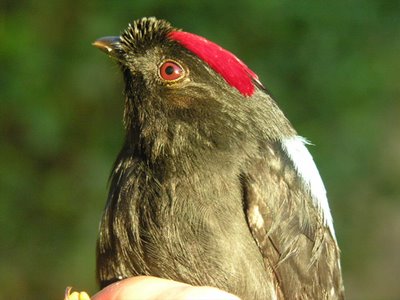 Here's the final installment of Making Manakins, in which I reveal some of my painting techniques with step-by-step photos of a long-tailed manakin painting in progress. Many thanks to Dan Mennill for the great reference photos in this and previous blogs! This one is a wonderful example of why it's really hard to judge colors in photographs. The low-angle tropical sun has washed out the bird's colors. But this image is great for feather texture and eye detail, and that's what I used it for. Man, what an appealing little bird!
Here's the final installment of Making Manakins, in which I reveal some of my painting techniques with step-by-step photos of a long-tailed manakin painting in progress. Many thanks to Dan Mennill for the great reference photos in this and previous blogs! This one is a wonderful example of why it's really hard to judge colors in photographs. The low-angle tropical sun has washed out the bird's colors. But this image is great for feather texture and eye detail, and that's what I used it for. Man, what an appealing little bird!It's time to put in the black. There is a great temptation when painting black birds to paint them other than black; to back off a bit and make them brownish or grayish; or to pump a lot of color into them, be it blue or green or violet. Which is fine if you're painting a grackle or some other iridescent black bird. But there are some birds that are just...black. Why should a manakin be iridescent, when its black plumage functions as a fabulous foil for its sky-blue back and crimson crown patch? It's more or less velvety, flat black. So I squeeze a dab from my tube of Ivory Black and get to it. As I paint, I can hear the great late bird painter Don Eckelberry's rough voice hollering, "If the bird is black, paint it BLACK!" OK, Don!
Ivory black is really fun to work with. It's made from burnt bones. Cow bones, I think. The pigment particles are really fine and it dilutes to a fine, but still black, wash. I adore it. The first bird is painted in about a half-hour.
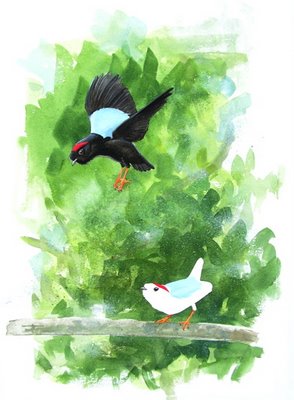 You may have been wondering how long this painting took to complete. I spent a good six-hour day composing and making thumbnail sketches, and figuring out where my darks and lights would go. The painting went faster though; I started at about 9 AM and was done and out the door for a hike by 3 PM. This, with breaks to snuzzle Chet Baker and take photos, chase butterflies around the yard and such springtime things.
You may have been wondering how long this painting took to complete. I spent a good six-hour day composing and making thumbnail sketches, and figuring out where my darks and lights would go. The painting went faster though; I started at about 9 AM and was done and out the door for a hike by 3 PM. This, with breaks to snuzzle Chet Baker and take photos, chase butterflies around the yard and such springtime things.Here's the final piece. The black tail streamers were the last thing to go in. I loaded a round brush up well with paint and did each one in a single fluid stroke. The older the bird, the longer the tail plume, but I'll spare you the ramifications behind that. These are geezers!
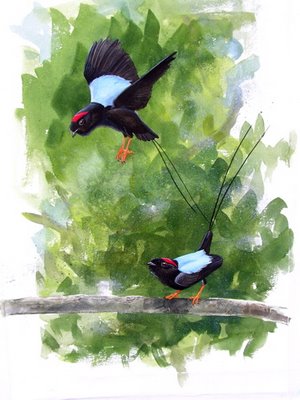
Here they are in close-up, minus their tails, just so you can see a little more of the detail and brushwork.
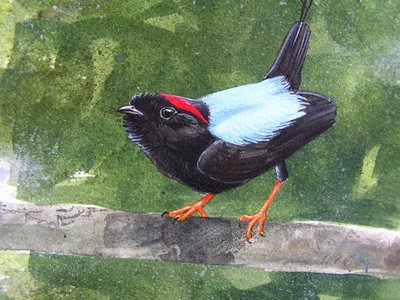
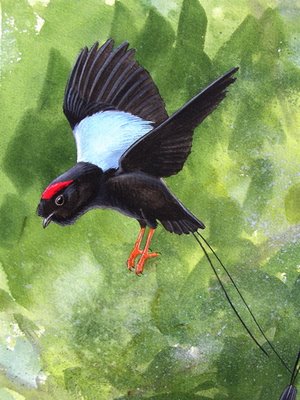
I took it outside to photograph it (I like to shoot my paintings in full sun, then come back inside and correct the overexposure and juice the colors right back up to where they should be). Chet Baker was prone on the sidewalk, baking his liver and lights. He's been waiting to do this all winter.
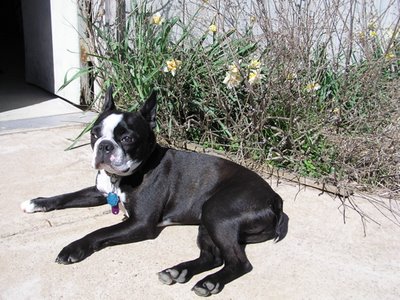 He heaved himself up sleepily when he heard my camera jump to life.
He heaved himself up sleepily when he heard my camera jump to life. 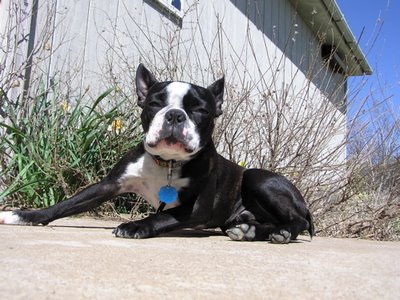 And, sure that I had come outside just to photograph him, struck a perfect, monumental Baker pose before flopping back down on the sidewalk. I read an interview with William Wegman (he of the dressed-up Weimaraners) in which he said that his dogs loved to work and pouted when he wasn't dressing them up and posing them in the studio. Chet obviously considers striking poses part of his job description. It has nothing to do with food rewards--having his picture taken is reward enough for Chet.
And, sure that I had come outside just to photograph him, struck a perfect, monumental Baker pose before flopping back down on the sidewalk. I read an interview with William Wegman (he of the dressed-up Weimaraners) in which he said that his dogs loved to work and pouted when he wasn't dressing them up and posing them in the studio. Chet obviously considers striking poses part of his job description. It has nothing to do with food rewards--having his picture taken is reward enough for Chet.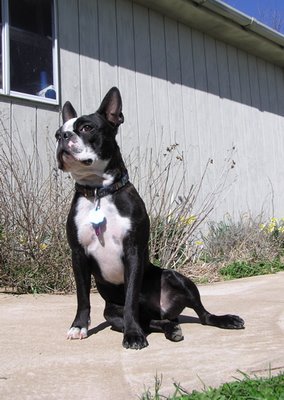 Not wanting to break his bubble, I took the photo-op. Yes, Chet, it's all about YOU.
Not wanting to break his bubble, I took the photo-op. Yes, Chet, it's all about YOU.






<< Home